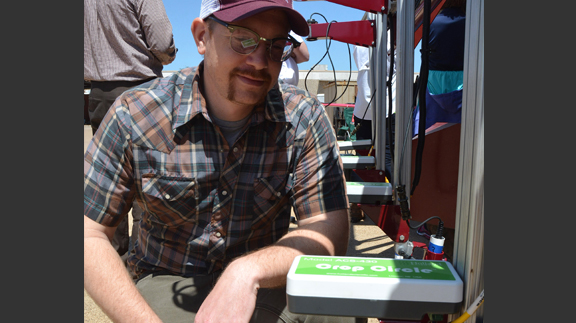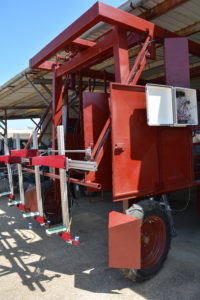Farm & Ranch
[AgriLife Today] AgriLife research remote sensing technology aims to solve critical crop diseases

By: Blair Fannin
- Writer: Blair Fannin, 979-845-2259, [email protected]
- Contact: Dr. Alex Thomasson, 979-458-3598, [email protected]
COLLEGE STATION – Sensor technology could possibly solve many challenges of crop production, and Texas A&M AgriLife Research faculty are aggressively attempting to find new solutions.
Dr. Alex Thomasson, an AgriLife Research biological and agricultural engineer, and Dr. Seth Murray, AgriLife Research corn breeder, both in College Station, and others are working jointly on several projects.
One project, an unmanned ground phenotyping system, provides data that can be used to aid decisions in breeding and production agriculture through techniques like conceptual modeling and spatial prediction, according to the scientists.
“We can also look at other characteristics like the drought tolerance of the plant. The data these machines collect will ultimately enable the breeder to make selections from the best varieties and to do so much quicker.”
Thomasson and other AgriLife and U.S. Department of Agriculture scientists are developing the ability to use remote sensing to detect and treat cotton root rot. Cotton Incorporated has been a strong supporter of this research, some of which is occurring at the Stiles Farm at Thrall.
“The cotton root rot project involves a lot of remote-sensing work to detect the locations of infection within individual fields,” he said. “It’s expensive for cotton farmers, not only the yield losses from the disease but the treatment to prevent it. It’s costing them about $50 an acre to treat the fields, but this research can save them a lot of money by enabling them to treat only the infected areas of a field. Some are trying to use satellite data to identify infected areas, but the image resolution is low. We’ve begun using UAVs (unmanned aerial vehicles), which give us images with extremely high resolution. We have the potential to see where each infected plant is so we can know exactly where to place fungicide in subsequent seasons.”
The remote-sensing research is related to a broader scope of research projects implemented by AgriLife Research. The Texas A&M Coordinated Agricultural Unmanned Aerial Systems project and Ground Vehicle Validation is a collaboration of more than 40 faculty members within the Texas A&M University System.
An unmanned ground phenotyping vehicle is being tested to collect real-time crop data. (Texas A&M AgriLife Research photo by Blair Fannin)
Led by AgriLife Research, the project also involves the Texas A&M Engineering Experiment Station, the Center for Autonomous Vehicles and Sensor Systems, and the Center for Geospatial Applications and Technologies, as well as businesses and farmers. The research centers on 1,400 acres of AgriLife Research fields near College Station where corn, cotton, sorghum and wheat, as well as peaches and perennial grasses are grown.
For more, visit http://bit.ly/1TZMBl1 .
-30-
Find more stories, photos, videos and audio at http://today.agrilife.org
Farm & Ranch
Hazards of Backyard Poultry

By Barry Whitworth, DVM
Having backyard poultry is a popular agriculture enterprise. According to the United States Department of Agriculture, 0.8 percent of all households in the United States have chickens. People keep chickens for a variety of reasons with table eggs being one of the more common reasons.
Unfortunately, some of these poultry producers are not aware of the hazards that come with keeping poultry because many times they carry pathogens but appear healthy.
Chickens are carriers of several zoonotic diseases. These are diseases that can be passed from animals to humans. According to a recent survey in Pennsylvania, a majority of backyard poultry producers were aware of the dangers of avian influenza. However, this study also revealed that far fewer producers were aware of the risk of possible exposure to Salmonella and Campylobacter.
The lack of knowledge about the hazards of raising poultry likely contributes to the continued issues of Salmonella outbreaks associated with backyard poultry. In 2023, the Centers for Disease Control and Prevention reported 1,072 illnesses of Salmonella linked to backyard poultry, and 272 of those patients required hospitalization. Oklahoma reported 43 individuals with the disease.
To read more, pick up a copy of the April issue of NTFR magazine. To subscribe by mail, call 940-872-5922.
Farm & Ranch
Ag Elsewhere: Wyoming

By Tressa Lawrence
Babies are tucked away in every nook and cranny. Many ranchers across Wyoming have baby animals popping up all over this time of year.
Farm & Ranch
Ag Elsewhere: Montana

By Lindsey Monk
Another load of grain in to keep feeding the calves until the green grass can really start popping.
-

 Country Lifestyles1 year ago
Country Lifestyles1 year agoScott & Stacey Schumacher: A Growth Mindset
-

 Equine7 months ago
Equine7 months agoThe Will to Win
-

 Country Lifestyles7 years ago
Country Lifestyles7 years agoStyle Your Profile – What your style cowboy hat says about you and new trends in 2017
-

 Country Lifestyles4 years ago
Country Lifestyles4 years agoAmber Crawford, Breakaway Roper
-

 HOME7 years ago
HOME7 years agoGrazing North Texas – Wilman Lovegrass
-

 Country Lifestyles7 years ago
Country Lifestyles7 years agoDecember 2016 Profile, Rusty Riddle – The Riddle Way
-

 Country Lifestyles8 years ago
Country Lifestyles8 years agoJune 2016 Profile – The man behind the mic: Bob Tallman
-

 Outdoor9 years ago
Outdoor9 years agoButtercup or Primrose?







